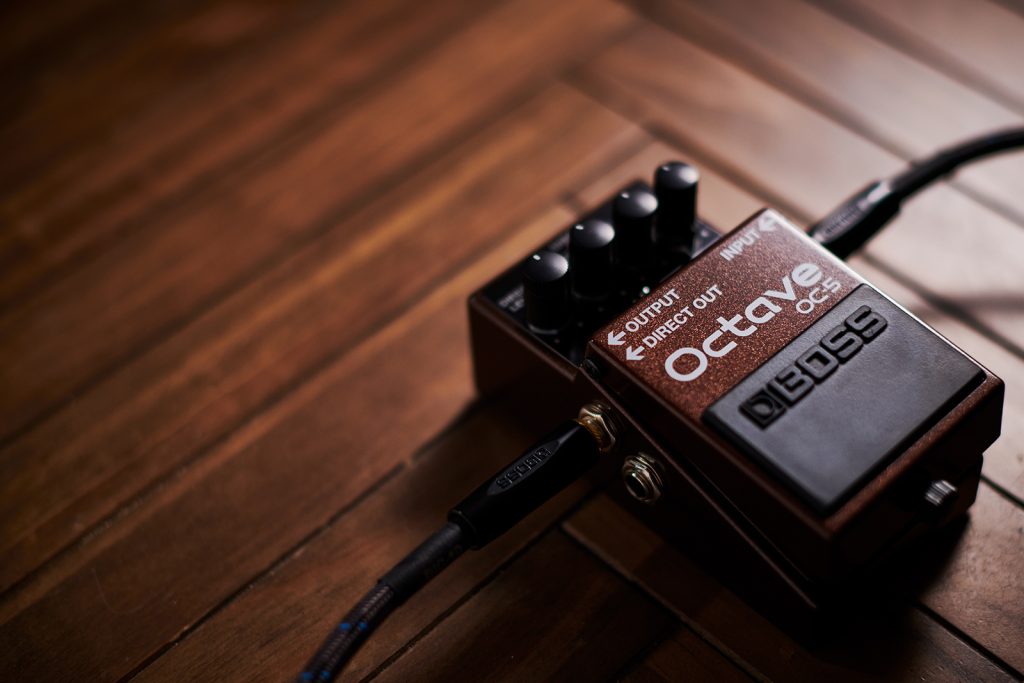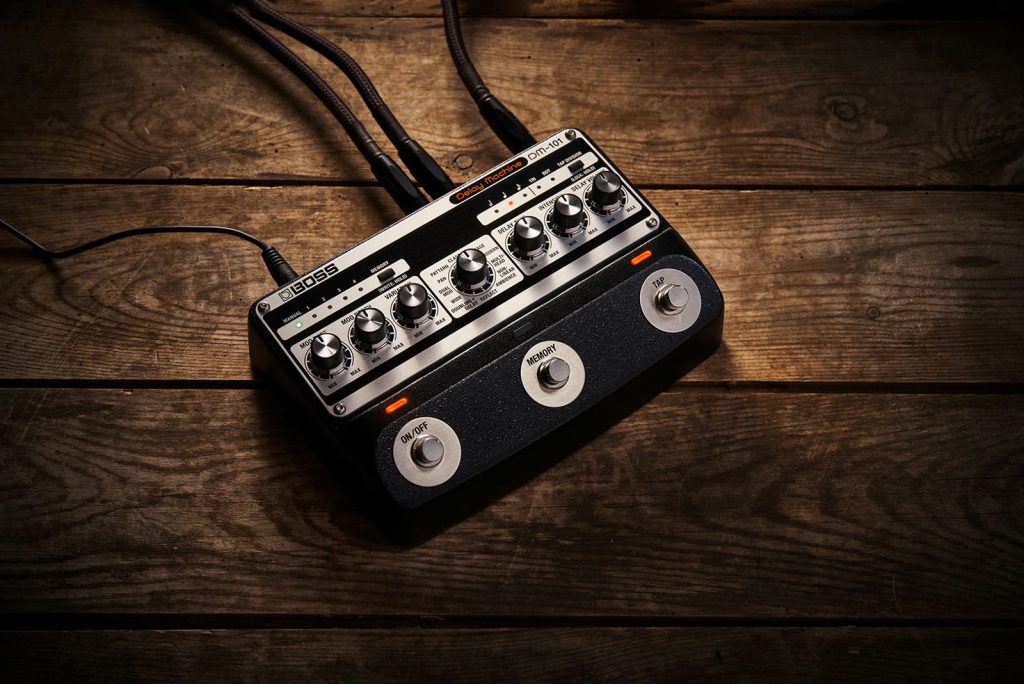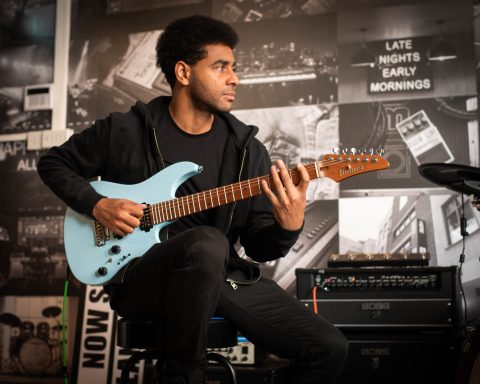A compressor pedal is a brilliant tool to enhance a guitar tone. It can be the backbone of any setup, helping to shape and define every pedal it’s paired with. Compression is more common as an always-on effect. As essential to tone as guitar pickups, compression works with other effects to create scores of interesting sounds. Learn to get the most from this dynamic pedalboard mainstay.
Setup Tips
As discussed in “Five Creative Ways to Use a Compressor Pedal for Guitar,” compression is most effective when we position it at the front of an effects chain. Its primary purpose is to limit an instrument’s dynamic variation. While that helps enhance playing attack, dynamics are often fundamental to other effects types. For example, overdrive or distortion expands dynamics and boosts the guitar signal. Position a compressor pedal after overdrive or distortion, and it would alter and limit the characteristics of the effect.
Pairing Compression with Other Effects
When using a compressor as an always-on tone-enhancing tool, the settings must be subtle. For example, the attack and sustain controls of a BOSS CS-3 must remain at 12 o’clock to avoid squashing or boosting the signal to a pronounced point. This setting creates enough transparency to avoid switching the pedal on and off while the compressor can still level out the tone.
However, a compressor pedal can be most effective in more extreme settings. Pairing a compressor with other effects often requires the compressor to squash or expand the guitar. In this case, using the compressor as an always-on effect would become difficult. Instead, players must use it carefully with other combinations to get the best results.
PEDAL COMBINATIONS
Sub-Octave
Sub-octave pedals, like the BOSS OC-2 and OC-5, can make a guitar sound more like a synthesizer. Blending a clean guitar signal, a -1 octave, and a -2 octave at similar levels creates a wall-of-sound tone that can dominate the sonic spectrum.

Enhance that synth-like tone by adding a compressor pedal to the mix. Set the ratio at its lowest and sustain at its highest to create a squashed, unnatural guitar tone. The compressor will add articulation to the lower octaves. Plus, the clean tone will sound more artificial, and the 3-octave signals will sound more unified and less like the natural dynamics of a guitar.
Recommended Pairings
- BOSS CS-3 and OC-5
- BOSS CP-1X and OC-5
"Enhance a synth-like tone by adding a compressor pedal to the mix. The compressor will add articulation to the lower octaves."
Fuzz
Fuzz can be a very tricky effect type to use in the context of a full band mix. While it sounds great on its own, the tonal characteristics of a fuzz pedal can get lost against the frequencies created by a drummer and bass player. Compression can bump up some of those missing frequencies. This controls and boosts a fuzz to a place where it is audible in a mix without altering the natural tone of the pedal.
In this context, consider the compressor an exciter or tone stack for a fuzz pedal. Use the overall level control of the compressor pedal to boost the fuzz pedal to a point where it is audible in the mix. Then adjust the compression or ratio and sustain controls to limit unwanted frequencies. This is an excellent method to ensure the resulting tone is heavy without sounding overly harsh and unwieldy.
Recommended Pairings
- BOSS CS-3 and FZ-1W
- BOSS CP-1X and FZ-5
"Compression can control and boost a fuzz to a place where it is audible in a mix without altering the natural tone of the pedal."
Delay
An excellent method for getting extreme delay settings is to pair a delay pedal with a compressor after the delay pedal in the effects chain. While this is an unusual place for a compressor, it can be very effective for creating huge wall-of-sound tones with the delay pedal.
The compressor will naturally compress the delay tails and the guitar’s clean signal. This behavior is like a feedback control on full rotation but without the inherent self-oscillating loop of the delay pedal alone. The pairing creates a punchier delay tone and works well for short delay times and weird glitch effects.
Recommended Pairings
- BOSS CS-3 and DM-101
- BOSS CP-1X and DM-2W

Reverb
Reverb is an effects type that’s original purpose was to emulate the natural ambiance of large rooms in any situation. However, how guitarists use reverb today has evolved over the years into something entirely new. Ambient reverb and shimmer effects have become a staple for everything from pop to post-rock. Sometimes, creating these massive walls of swirling modulated reverb can get out of hand and become overpowering. Compression is crucial for controlling and tempering the wild oscillations of ambient reverb.
In this case, the compressor doesn’t need an overly compressed setting. But it’s crucial that the attack or compression control act as a limiter to make sure the player doesn’t exceed a particular volume.
When used with an ambient reverb, the compressor’s job is to prevent frequencies from over-oscillating or jumping out from the mix. This might seem like quite an unglamorous use of the compressor. However, an ambient reverb with a long decay can be difficult to maintain an even effect. Using a compressor keeps the effect controllable and adds subtle clarity.
Recommended Pairings
- BOSS CS-3 and RV-6
- BOSS CP-1X and RV-500
"Compression adds clarity and definition and helps get the most out of almost all other pedals."
Icing on the Cake
In all these examples, the compressor pedal acts more as the icing on the cake than the cake itself. Compression isn’t an especially overt effect type, but it is essential, lifting, honing, and expanding the effects with which it’s partnered.
A compressor can be the cornerstone of every other effect combination on a pedalboard. Compression adds clarity and definition and helps get the most out of almost all other pedals. Experiment with using it in both subtle and extreme settings. It may become the most trusted pedal in your arsenal.






